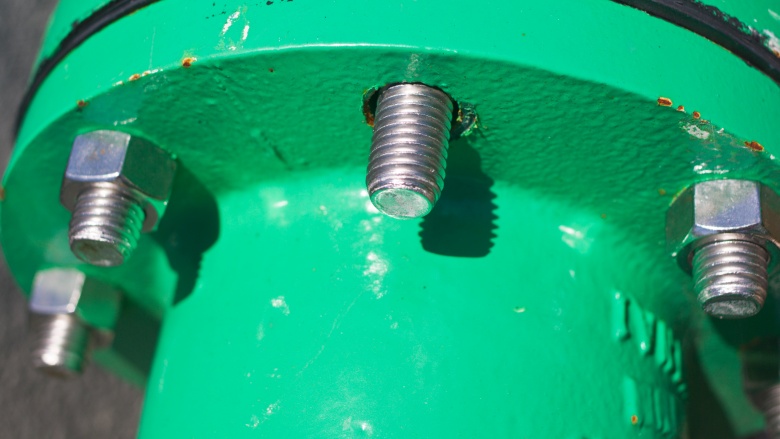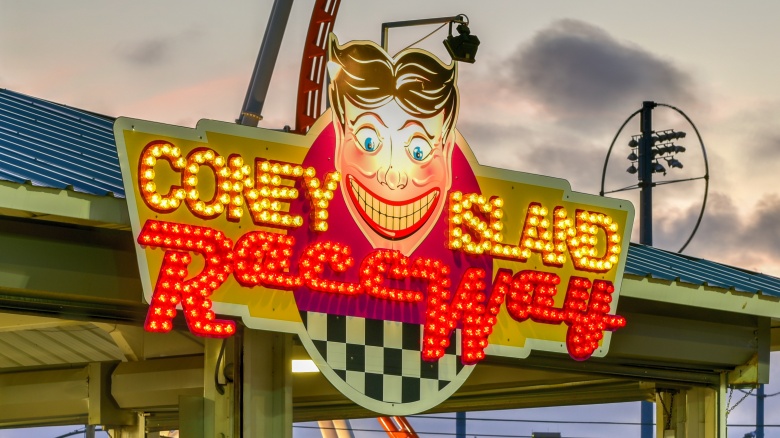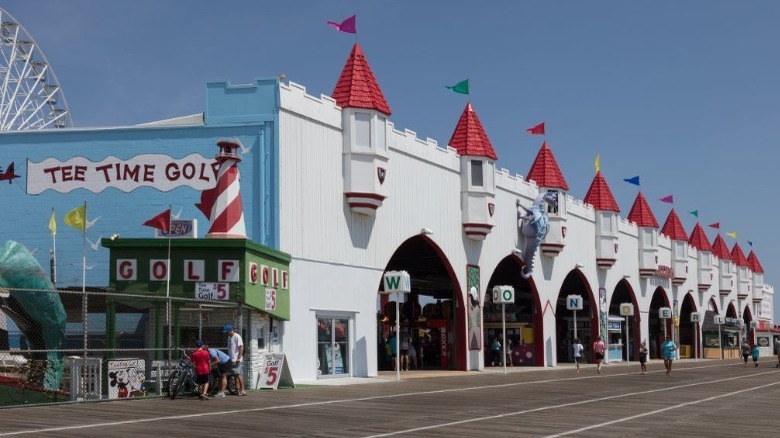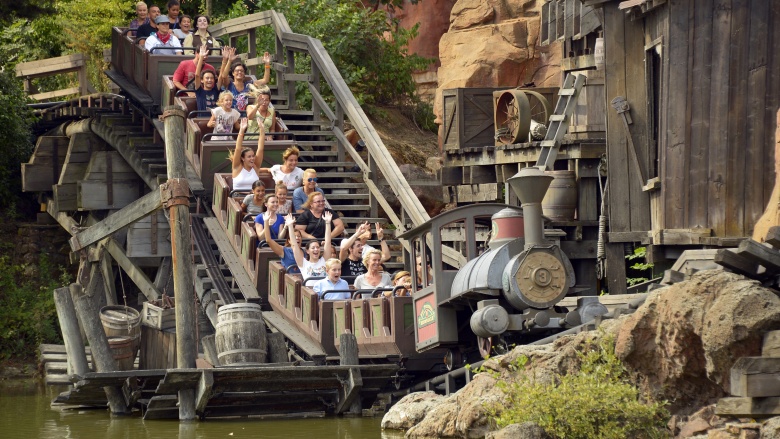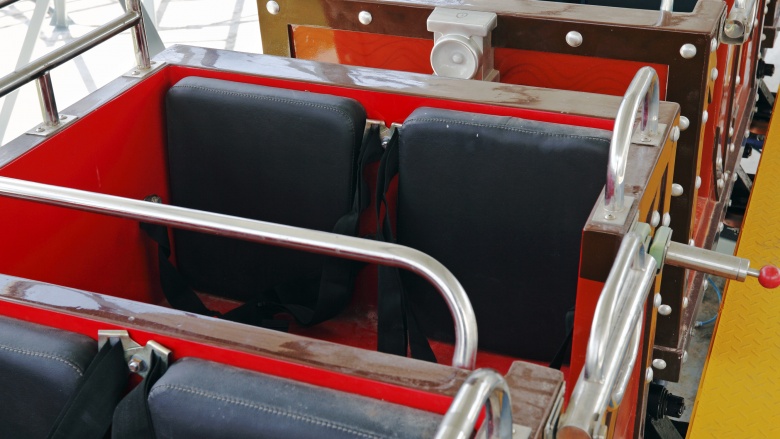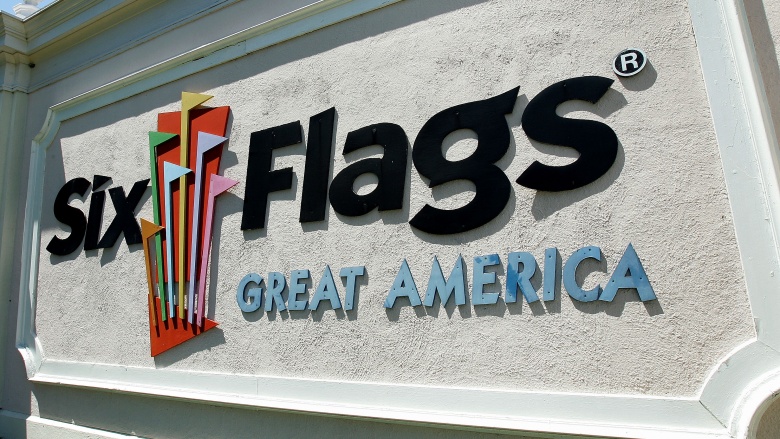15 Most Deadly Roller Coaster Accidents
The odds of dying in a roller coaster accident are relatively slim. According to a report from the National Security Council, thrill seekers have about a 1.5-in-a-million chance of even being injured on one. One look at the details of the deadliest roller coaster accidents of all time, though, and you might have a little more pause before strapping in. You'll probably at least triple-check the harness and frantically search for any loose screws before you're go for launch.
1972: The Big Dipper (London, England)
The Big Dipper had been the central attraction at London's Battersea Park funfair for two decades, before the wooden coaster took a tragic turn on May 30, 1972. The ride malfunctioned, when the rope hoisting one of the trains upward broke loose and sent the carriage line on a backwards free fall the ride's operator was unable to slow with the ride's braking mechanism. The tail car came off the rails when it came upon a turn and "crumpled" into the barrier, after which the two other cars attached crashed on top of it, killing five children and injuring 13 others.
The operator's son, John Collins, later explained the disaster was "a combination of malfunctions which shouldn't have happened." One girl, who was on the ride and witnessed the catastrophe unfolding, described the gruesome accident by saying, "we went 'round the corner, and the first carriage had just reached the top, and I think the cable broke, I don't know, and it all came backwards very quickly." Another child who saw the crash said that it was "most of the people in the back [who] got all crushed up in there." The coaster was immediately dismantled, and the entire fair eventually closed altogether. Survivors of the incident say they still experience mental distress as a result of the gruesome scene.
1930: The Big Dipper (Omaha, Nebraska)
Perhaps the name "Big Dipper" should just be off-limits for roller coasters — this time, it was in Omaha, Nebraska's Krug Park (now called Gallagher Park) on July 24, 1930. A bolt loosened from the coaster, sending four cars full of kids and teenagers plummeting to the ground. Four people were killed, and 17 were injured by the crash, and the ride was immediately closed.
The deadly incident also prompted the city's council to immediately pass an ordinance banning roller coasters in the park, and it was eventually closed a decade later. The city did later allow the creation of Peony Park, which included the Galaxy coaster, but that park also saw more than its fair share of fatalities, and eventually closed in 1994 due to dwindling attendance rates.
1986: Mindbender (Alberta, Canada)
The indoor Mindbender coaster at West Edmonton Mall in Alberta, Canada was reportedly declared safe by an inspector just one day before its rear car came off its tracks on June 14, 1986, due to missing wheel assembly bolts. As CBC reports, four passengers were hurled from the car, which was going about 60 miles per hour, after it struck a pillar. Three didn't survive, and 19 others to the hospital with serious injuries.
A man named Rod Chayko was in the last car and survived the incident, but with devastating injuries, such as a broken pelvis, shoulder, ribs and legs, a punctured lung, plus he had to re-learn to walk. He later described the scene in ghastly detail, telling the Toronto Sun, "We had gone up and were done [with] the big drop where we got our speed — we were getting ready to go into the whirlee and our car started to fishtail. I grabbed onto the safety bar we had back then and I held on, but the next time it went over, my lap bar was released. I flew."
The ride was redesigned, repainted, re-opened months later, and still runs to this day.
1915: Rough Riders (Coney Island, New York)
Coney Island's Bowery kept the tracks rolling on its Spanish-American War-themed Rough Riders roller coaster, even after four people were killed in 1910 when an operator allowed cars to round corners much too quickly — as a result, two cars containing 16 people were thrown off a 60-foot precipice.
Another trio of fatalities happened in a similar incident on July 28, 1915, which finally shut down the ride. Here, one car's excess speed caused it to leave the track and flip to its side, catapulting three people to their deaths, injuring the driver and a woman on the ground, while another woman caught onto the railing with one arm, and her four-year-old boy with the other. They were ultimately rescued by two policemen, who climbed onto the rattled railing and pulled the pair to safety.
2007: Fujin Raijin II (Osaka, Japan)
If a roller coaster that allows its passengers to stand sounds like a bad idea, maybe it's because it is. Japan's Expoland became the site of a horrific disaster on May 5, 2007, when the wheel axle on one of the cars of its standing Fujin Raijin II ride came loose, hurling its passengers into a guardrail, killing one 19-year-old student and injuring 19 others. Even worse, it was Children's Day, so many of the riders were kids.
One witness to the scene said, "the roller coaster was swinging left to right." Even those who weren't watching could tell something was wrong when they "heard a scraping sound followed by people screaming. It came to a halt at last after a sound I can hardly describe in words." Another woman, who'd ridden just before the accident, claimed to have experienced a feeling of nearly being thrown from the ride during her run.
The park, which had been open since 1972, reopened that year, but closed a few months later due to dwindled customer patronage.
1999: Wild Wonder (Ocean City, New Jersey)
On August 28, 1999 the Wild Wonder roller coaster suffered multiple mechanical failures, which caused a car to lose traction and plummet 30 feet backwards towards a sharp curve. This killed a 39-year-old woman and her eight-year-old daughter, after they were ejected from their car due to the force of the turn, and injured two others.
In addition to the drag chain of the ride releasing prematurely, the ride's safety features — including the pair's lap bar and the built-in anti-rollback safety mechanisms — also failed to prevent the gruesome accident. "I saw the car going up," said one witness, "then something let loose and the car came slamming back downward, slamming down. I saw two bodies fly, incredibly. It was a woman and a child. The woman slammed into a beam. The child just flew. I knew right away they had to be dead."
The ride was immediately closed and removed from Gillian's Wonderland Pier, although the park itself is still fully operational.
1997: The Wildcat (Tulsa, Oklahoma)
Bell's Amusement Park's Wildcat ride turned into a place of chaos on April 20, 1997, when one of the cars disengaged from the tracks while ascending its hill, causing it to careen backwards into another vehicle. A 14-year-old boy in the front car was ejected, hit his head, and fell to his death. Six other passengers were injured.
"It was terrifying," said one of the adult riders on-board, whose nine-year-old daughter was among the injured, after she was ejected and hit her head on a metal beam. "There was nothing we could do to prevent it ... It shook my insides, it was so hard." The ride, which had been inspected two weeks prior to the incident, was then dismantled and relocated to Ocean City, Maryland's Jolly Roger Amusement Park and renamed The Avalanche. It operated from 2008 until 2014, when it was sold to a park in Lima, Peru.
2003: Big Thunder Mountain Railroad (Los Angeles, California)
Disneyland was decidedly not the happiest place on Earth on September 4, 2003, when improper maintenance of the park's Big Thunder Mountain Railroad led to the derailment of the leading locomotive car. It separated from the cars, became airborne, and landed on top of the leading passenger car, killing one 22-year-old man and injuring 10 others. The lone casualty reportedly died after bleeding out from blunt force trauma to his chest. His family sued the park, and settled for an undisclosed sum.
It was the second major incident involving the ride, following a 1998 event in which a five-year-old boy's foot was trapped between the passenger car and the platform. He had tried to exit during a brief stop near the end, thinking the ride was over. All of his toes had to be amputated as a result of the awful injury.
1980: Willard's Whizzer (Santa Clara, California)
Willard's Whizzer at Marriott's Great America Amusement Park was known to have had issues with its braking system prior to March 29, 1980, when the ride's faulty mechanics sent one car crashing into another, smashing into would-be passengers attempting to board the ride. A 13-year-old boy suffered fatal internal injuries to his chest and abdomen as a result of him falling on the rocks below, and eight others were also hurt.
An employee of the park told press that "two systems had to break down for this to happen," including an electric safety mechanism which ensures adequate distance between cars. "The odds against that happening must be astronomical." The ride was later modified and renamed, before closing in 1988.
1989: Puff the Little Fire Dragon (Farmington, Utah)
The historic Lagoon Amusement Park has seen an alarming amount of devastation. Most recently, a 13-year-old girl was killed when she tried to stand up on the site's wooden roller coaster ride, and fell 35 feet to her death. Before that, a 20-year-old man had died the exact same way back in 1934, and a 23-year-old was killed while performing maintenance work on the coaster back in '46.
That same park was the site of another horrific coaster-related child death in 1989, when a 6-year-old boy riding the Puff the Little Fire Dragon ride stood up after it came to a halt, thinking it was over. However, the operator put the ride back into motion for another round while he was halfway out of the vehicle. He fell through the tracks, and was attempting to climb back up when he was stricken by the car as it was returning to the station while his horrified parents helplessly watched on.
2001: Treetop Twister (Ripon, England)
The Treetop Twister at New Yorkshire's Lightwater Valley theme park was a brand new addition that the park proudly billed as a "hair-raising cross between a roller coaster and a waltzer." It had only been in operation for a month before it cost one British student her life, on June 21, 2001. Several of the cars crashed into one another, after an overlooked wiring mistake over-rode the emergency systems which should've prevented the collision.
The victim's boyfriend, who was among several who were also injured by the accident, described the moments leading up to the crash, saying the couple "noticed a car in front and ... knew something was wrong. We went halfway up a slope and hit the car and rebounded. We saw a car behind us coming round the corner and we went backwards and hit it." The 20-year-old woman, Gemma Savage, died after being air-lifted to a hospital after suffering severe head and spinal injuries. Her family sued the park, but her death was ruled a misadventure, rather than an unlawful killing, and no charges were brought against the ride's maintenance worker.
Despite its devastating beginning, the ride still remains in operation under the abbreviated name Twister, and was the site of another dangerous flub, when a worker started up the ride as a joke while another was doing checks on it. The victim was thrown 13 meters into the air before another attendant stopped the motion before it could cause further harm, but she was still traumatized.
2013: New Texas Giant (Arlington, Texas)
Six Flags Over Texas aimed to honor the state's reputation for boasting bigger things, when it refurbished its Texas Giant in 2011 into a 153-foot-tall steel behemoth. It was also the site of a gruesome disaster on July 19, 2013, when a 52-year-old woman named Rosa Esparza fell from her seat on the ride and dropped seven stories to her death. Her son was with her on the ride, and screamed for the operators to halt.
Her body was later discovered by authorities, nearly severed in half on the roof of the ride's tunnel which covers the lower track. After investigating the cause of the accident, Six Flags ruled out mechanical failure, but did add in additional security measures, including re-designed restraints and new seat belts as well as a test seat for patrons to determine if they will fit in the ride, before re-opening a few months later. Esparza's family sued the company and ultimately settled for an undisclosed sum, agreeing that the park would not accept fault for the accident.
2011: Python Pit (Norridge, Illinois)
Even kiddie coasters have been known to turn deadly. A three-year-old boy named Jayson Dansby was riding an indoor mini-coaster with his twin brother at Go Bananas in Norridge, Illinois on April 2, 2011, when he wriggled out of his restraints and stood up. He soon lost his balance and fell backwards to his death, after being wedged between the moving cars. The toddler's parents witnessed the tragedy, and the center's owner was charged with not keeping maintenance records on-hand for investigation.
The boy's parents, along with several witnesses, sued the site after the incident, but the park reopened just a few days later, after passing a state inspection. The ride is still operational to this day.
1983: Black Witch (Myrtle Beach, South Carolina)
Myrtle Beach's Magic Harbor earned the nickname "Haunted Harbor" after a 13-year-old girl was thrown from its Black Witch coaster on April 3, 1983. Witnesses said the girl, Sherri Depew, was seated properly for the ride, but her lap bar came undone partway through. "She wasn't doing anything," said a fellow rider whose own, functional restraints restricted him from helping her. "It just popped her over the front seat. She was trying her best to bring herself back in, but there was nothing to reach for."
Depew's family sued the park for her death, claiming that it'd been aware of the potential hazards of the ride, but employed incompetent operators to staff it. The park ultimately shut down in 1999.
1984: Rail Blazer (St. Louis, Missouri)
Six Flags Over Mid-America was the site of a sudden calamity on July 7, 1984, when 46-year-old Stella Holcomb slipped from the new standing Rail Blazer coaster, and was flung 20 feet to her death. "As we made this sharp whip, she was gone, just like that," her husband, who was also on the ride, said of her fall.
Park managers touted the ride's safety design after the incident, saying "we have a locked shoulder brace, a knee harness, and a third safety belt that's also locked on top of it, so from a theoretical standpoint that shouldn't have occurred." They also suggested that she may have fainted during the ride, and that her weight may have been a factor as well, but her husband disagreed with that assessment. Her family settled with the company for $1.8 million, and the park replaced its standing coaster cars with the original train cars that had been in place for a decade before.

